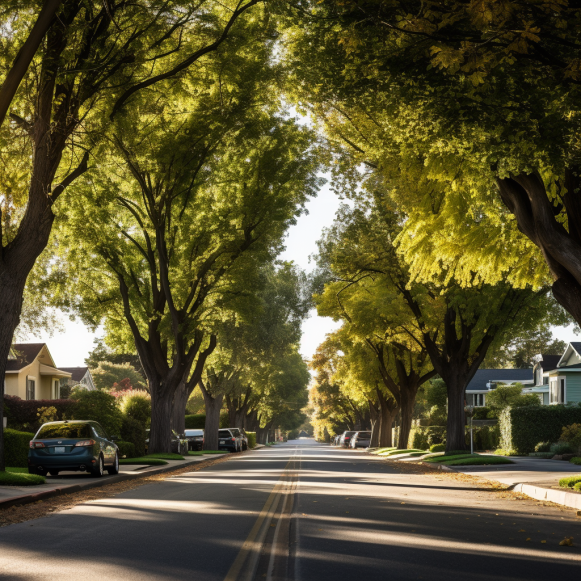Thousands of new trees coming to 10 Bay Area cities in bid to right old wrongs, address climate change

San Jose official calls tree grant “unprecedented”
Only a single scruffy tree grows between the sidewalk and the street on the block where Consuelo Ramirez and her four children live in Oakland’s flatlands. Others emerge from backyards. Spacious homes nestle beneath leafy, green canopies in the Oakland hills to the east, and trees line every road.
“They have more money,” Ramirez, a single mother who retired at the age of 53 due to a workplace injury, said of her near neighbors.
And because those in the hills have more money and more trees, they have more shade, cooler summer days, more peace and quiet, more birds, squirrels, and other animals — and, according to experts, a likely higher quality of life.
Now, neighborhoods like Ramirez’s are set to become greener thanks to a grant program designed to cover the heads of those most affected by the climate crisis.
Under a $1 billion program funded by the U.S. Inflation Reduction Act, ten Bay Area cities have received federal grants to plant, maintain, and restore trees, including $8 million in Oakland and $6.6 million in San Jose.
“It’s historic, it’s unprecedented,” said Colin Heyne, a spokesman for the city of San Jose. “We’ve got this infusion of funding the likes we’ve never seen before for San Jose street trees.”
The grants are targeted at census tracts identified as disadvantaged by the federal government. Increasing the tree canopy in poorer urban areas, including improvements on a single block, lowers temperatures during heatwaves and provides residents with a “enhanced sense of well-being,” according to San Jose State University professor Katherine Cushing, chair of the Environmental Studies department. Cushing mentioned that providing shade reduces energy use and greenhouse gas emissions by removing pollutants, sequestering carbon dioxide, reducing runoff, dampening urban noise, and providing habitat for animals.
According to Ramirez, wealthier areas have more trees, and the extent of tree canopy overhead is closely related to the amount of money in residents’ bank accounts.
According to the non-profit American Forests, trees are often scarce in disadvantaged neighborhoods and communities of color, owing in part to government redlining policies dating back to the 1930s that barred non-White people from many areas. The interactive maps from American Forests show dramatic disparities among Bay Area cities and neighborhoods in what the organization calls “tree equity,” or “whether there are enough trees in a neighborhood for everyone to experience the health, economic, and climate benefits that trees provide.”
A 2021 Nature Conservancy study based on satellite imagery from 2016 found that in 92% of U.S. urban areas surveyed, low-income zones had 15% less tree cover than high-income zones, and were 2.7 degrees hotter on average.
A rarely enforced bylaw in San Jose requires homeowners to have and maintain at least one “street tree,” which typically grows between the sidewalk and the street. nevertheless “the cost of maintaining a healthy tree and dealing with the occasional sidewalk or curb repairs due to tree root damage is too much for many households,” Heyne stated.
San Jose’s proposal to the United States Forest Service, which awarded the federal grants, requested $8 million for a street tree project that would allow for the planting of 6,000 new trees and the pruning of 10,000 existing ones. The number of trees to be planted and pruned remains to be determined, Heyne said, because the grant amount is lower and includes $1 million for vegetation management at Alum Rock and Overfelt Gardens parks.
“We’re not planning on swooping in and planting a tree without a property owner’s consent,” he stated. Instead, city officials intend to conduct public outreach to “let the community know that there are these free trees” and that the city will handle and pay for the first three years of watering and maintenance to ensure survival, according to Heyne.
A 2020 city assessment in Oakland discovered that more than 70% of the city’s tree canopy was on privately owned property. David Moore, the city’s tree supervisor, noted that the stark differences in tree cover between the hills and much of the flatlands closely match historical maps showing redlined neighborhoods.
Oakland intends to use its grant funds to plant and restore trees not only along streets, but also in private yards, which Moore describes as “a very valid place for a tree to be planted.” Moore stated that the city intends to collaborate with local nonprofits Common Vision and the Oakland Parks and Recreation Foundation to plant trees in residents’ yards.
Oakland, too, received a smaller award than the $22.5 million sought, and will have to figure out how to divide the grant between street and yard trees, according to Moore.
The city will maintain the trees planted along roadsides for five years, including one pruning, according to Moore. New street trees typically only require watering for the first three years, but he recommends pruning every seven years.
Moore explained that tree species will be chosen based on their ability to adapt to climate change and resist drought. “That’s an important update to make so that the trees that we are planting not only help to mitigate the effects of climate change but also survive climate change,” Moore stated.
It remains to be seen which Oakland neighborhoods will benefit from new trees. Ramirez hopes to see some on her block, where she has lived in a rented home for the past eight years. It gets very hot in the summer, and she and her neighbors, especially the kids who play together in the hot sun, could use some shade, she said. She went on to say that “the neighborhood would look more pretty.”






